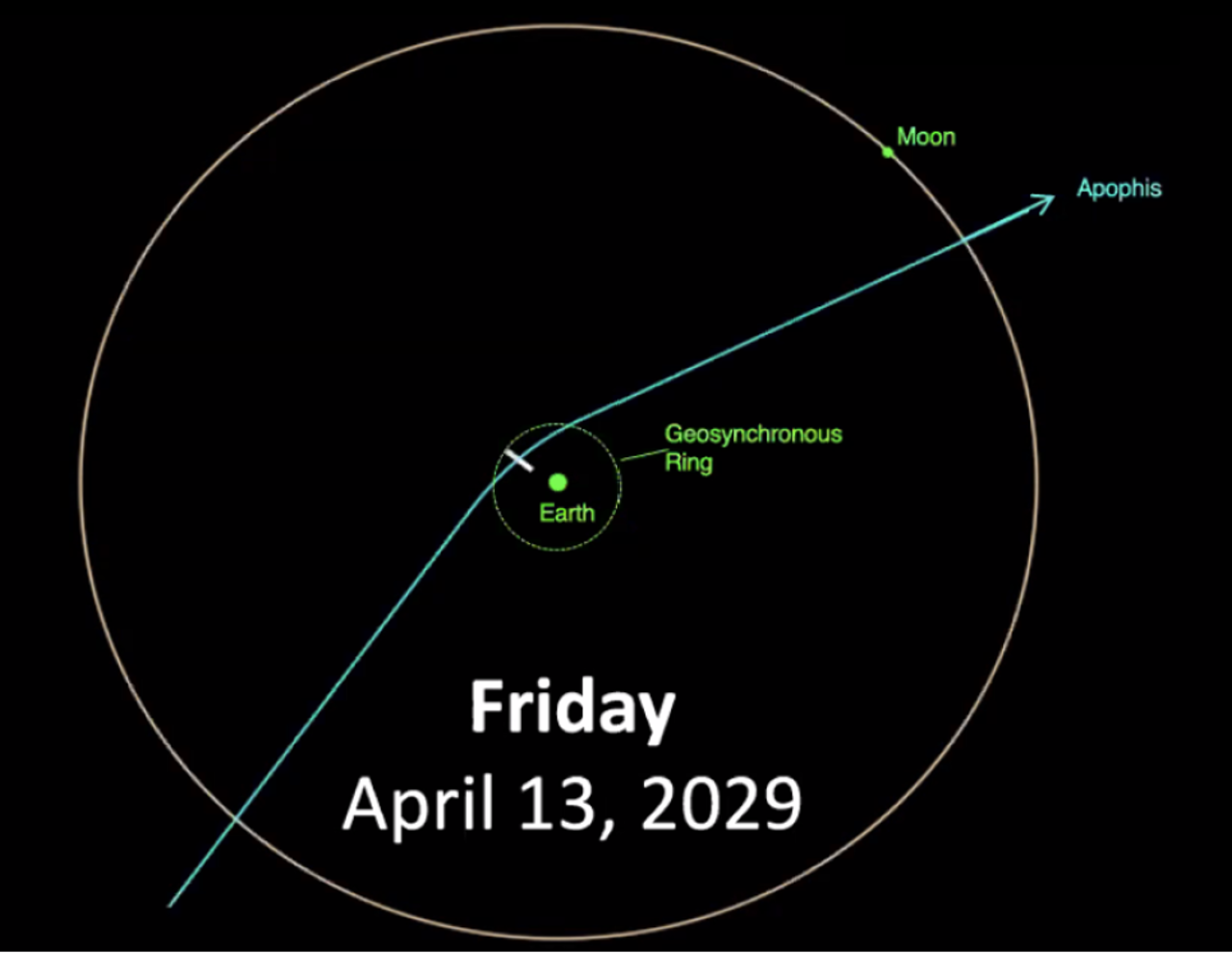Status of ESA’s Rapid Apophis Mission for Space Safety (RAMSES) Concept
- 1ESA/ESAC, Villanueva de la Cañada, Spain (michael.kueppers@sciops.esa.int)
- 2ESA/ESTEC, Noordwijk, The Netherlands
- 3Université Côte d’Azur, Observatoire de la Côte d’Azur, CNRS, Laboratoire Lagrange, Nice, France
The objective: 99942 Apophis is a potentially hazardous asteroid with a diameter of about 370 metres that on 13 April 2029 will approach Earth’s surface at a distance that is closer than orbiting geosynchronous satellites (Fig. 1). Significant tidal torques will be exerted on the body of Apophis, with consequences that might include alterations of its rotation state and/or internal structure, measurable seismic waves and real-time surface disturbances.
This very close Earth flyby therefore presents an unprecedented planetary defense and science opportunity. A mission to Apophis could allow transforming our understanding of the mechanical response to external natural forces of the surface, interior and rotational properties of potentially hazardous asteroid, with both planetary defense and science implications.

Figure 1: Trajectory of Apophis during its close encounter with Earth on 13 April 2029, at a minimum distance of 31860 km from Earth’s surface.
The mission: Parallel ESA-funded studies for small missions to Apophis are ongoing. The first is “Satis”, a study based on a 12U CubeSat; in parallel a second small-satellite study (“RAMSES”, Rapid Apophis Mission for SpacE Safety) is exploring an adaptation of the Hera spacecraft design, to fit to the updated mission profile, while minimizing any new developments given the short timescale until launch.
To rendezvous with the asteroid before April 2029, the RAMSES spacecraft needs to launch in 2028 with a 3-weeks launch window opening on April 20th. Following a 10-months direct transfer, RAMSES will rendezvous with Apophis no later than March 1st, 2029, and will perform a detailed characterization campaign of the Asteroid. Initially RAMSES will run passively-safe hyperbolic arcs with pericentre at 20 km from Apophis, then will move into a pseudo-hovering position with fixed relative distance and phase angle with respect to the target asteroid. The distance will be decreasing in consecutive steps from 20 km to 10, 5 and finally 1 km, At the closest distance, global imaging at 10 cm resolution will be achieved (exploiting the Apophis rotation). This series of observations will be performed both before and after the close encounter with Earth.
In addition, during the close encounter, characterization of Apophis with high temporal resolution (1 picture per minute) will be performed in a safe hovering position at 5 km to observe in detail the abovementioned physical and dynamical alterations of the asteroid.
The Spacecraft: RAMSES is largely based on the Hera design. The key design drivers with respect to the original mission profile are: a much reduced distance from the Sun (allowing smaller Solar Arrays and reduced heater power), a closer distance from the Earth during critical operations (allowing a smaller antenna), but an increased delta-V demand (introducing the need for larger tanks and/or lower dry mass).
Payload: RAMSES will embark as a minimum two visible cameras with complementary Fields of View and two 6U-XL CubeSats which will be released in proximity of Apophis before the close encounter and will operate independently, using RAMSES as relay satellite. One of the two CubeSats could possibly land on Apophis before the close encounter, carrying relevant instruments such as, e.g., seismometers or gravimeters. Additional payloads will be accommodated either on RAMSES or on the CubeSats on the basis of available on-board resources. These might include a Thermal Infrared Imager, a Laser Altimeter, a Multispectral Camera onboard RAMSES, and/or a Low Frequency Radar, and other possible instruments of interest for planetary defense and/or science purposes.
International Cooperation: RAMSES will work in synergy with the NASA mission OSIRIS-APEX that will arrive at Apophis a few days after the closest approach of the asteroid to the Earth, allowing a comparison of the asteroid properties measured by the two missions and emphasizing the international cooperation that is at the heart of planetary defense.
Conclusion: The study of RAMSES will be instrumental to make an informed decision at ESA’s Council at Ministerial Level in 2025, both on the most effective technical solution as well as the best approach to reduce mission cost and allow fast implementation.
How to cite: Küppers, M., Martino, P., Carnelli, I., and Michel, P.: Status of ESA’s Rapid Apophis Mission for Space Safety (RAMSES) Concept , Europlanet Science Congress 2024, Berlin, Germany, 8–13 Sep 2024, EPSC2024-199, https://doi.org/10.5194/epsc2024-199, 2024.